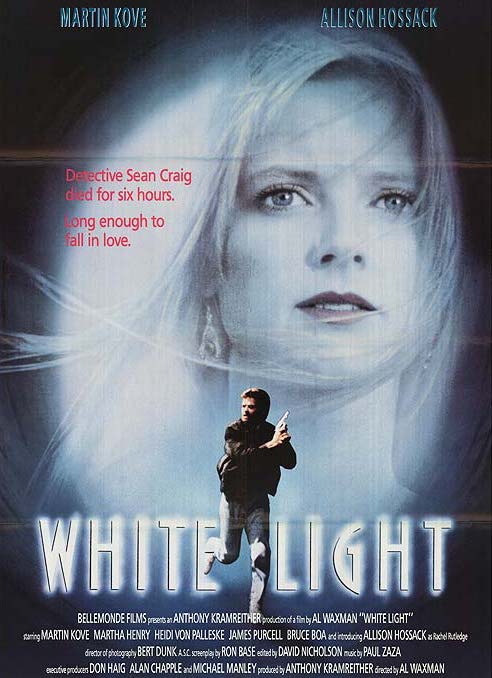Friday, May 17, 1991
WHITE LIGHT. Written by Ron Base. Music by Paul Zaza. Directed by Al Waxman. Running time: 90 minutes. Rated 14 Years Limited Admission with the B.C. Classifier’s warning "some violence, suggestive and very coarse language."
WE INTERRUPT THIS REVIEW to bring you a news bulletin from the frontiers of science.
"An afterlife," says Dr. Ella Wingwright (Martha Henry), "is not a myth that sustains people in the face of death.
"It's a medical fact."
Wingwright is a researcher whose experiments in the basement of Toronto's East General Hospital involve apes and the voodoo drug tetrodotoxsin.
She passes along word of this hitherto undocumented biomedical breakthrough during a conversation with with police detective Sean Craig (Martin Kove).
A serious student of the afterlife, she is intensely interested in Craig, an undercover cop shot and apparently killed by a mob assassin. Pronounced dead, the big guy returned to life hours later on an autopsy table.
Wingwright thinks that he may have had an NDE — a near-death experience. Craig knows he did.
He remembers jogging down a round, dark tunnel towards a bright White Light. He remembers being in a vacation cottage and meeting Rachel Rutledge (Allison Hossack), a beatifically beautiful blonde who greeted him like a welcome new lover.
When they embraced, she told him that "you're kissing a dead woman." Heaven (if that's what it was) was working out well for Craig.
And then he woke up.
In discussing his film White Light, director Al Waxman refers to such recent fantasy thrillers as 1990’s Flatliners and Ghost. The Toronto-born entertainer has always kept up with the latest market trends.
One of Waxman’s earliest directorial efforts was 1974’s My Pleasure Is My Business, a feature that benefitted from the notoriety of its star, “Happy Hooker” Xaviera Hollander, and the existence of a large, undiscriminating audience for softcore exploitation films.
Since then, he has honed his filmmaking skills directing episodes of such prime-time television series as Danger Bay, Street Legal and Cagney and Lacy.
Waxman knows how to get the proper cop show look. Given a pair of attractive performers like Kove and Hossack, he can even stage effectively erotic clinch scenes.
What his picture lacks is any sense of logical consistency. The White Light storyline makes about as much sense as Dr. Wingwright's medical "facts."
Waxman shares the blame with Ron Base, the Toronto novelist who made his screenwriting debut with the Canadian Flashdance clone Heavenly Bodies (1985). Here, Base mixes a formula police corruption plot, some New Age pseudoscience and some old hat precognition with all those trendy NDE elements.
There's a real trick to making a mess like this come together in a solid, satisfying dramatic package. Unfortunately, it's one that Waxman hasn't mastered.
White Light is a metaphysical mystery that misses the mark.
The above is a restored version of a Province review by Michael Walsh originally published in 1991. For additional information on this archived material, please visit my FAQ.
Afterword: Though currently Toronto-based, the career of Manitoba-born Allison Hossack fits into a neat capsule summary of Vancouver’s vibrant film and television industry since the mid-1990s. Following her feature-film debut in the Toronto-made White Light, she found her way to Vancouver, where she co-starred in the single-season action series Cobra (1993-94). The show was the creation of Steven J. Cannell, the Hollywood producer who became a key figure in the growth of the B.C.TV industry. During his decade on the local scene, he was responsible for making some ten series and building the North Shore Studios. Hossack went on to play a feature role in Cannell’s final series, the dramatically daring Profit (1996).
Cobra was first aired the same month (September 1993) as The X-Files, the show popularly credited with establishing Vancouver as North American television's fantasy central. Hossack, her heavenly credentials already firmly established, moved easily into the new era. Her credits read like a catalogue of B.C.’s woo-woo hits, a list that includes Sliders and The Outer Limits (both 1995). She's been a guest star on Viper (1997), Poltergeist: The Legacy (1996), First Wave (2000), Stargate SG1(2002), The Twilight Zone (2003), Stargate: Atlantis (2004), Eureka (2007), Reaper (2007-08), Fringe (2012) and, of course, the essential Supernatural (2008), where she played Sam and Dean Winchester’s maternal grandmother Deanna. In 2004, she had a principal role in the single-season Steven King project Kingdom Hospital.
Five years earlier, Hossack was a principal performer in the B.C.-made Hope Island (1999-2000). A single-season family drama, it was made for the niche-market PAX TV, a channel aimed at the family-entertainment audience. PAX anticipated The Hallmark Channel, which went to air in 2000 and included on its schedule five new feature films. Two of those pictures — A Storm in Summer and Personally Yours — were shot on location in B.C., while two others were made in the U.K. Although I’ve not been able to establish precisely where the fifth movie was filmed, the presence of a number of Vancouver-based performers in the cast strongly suggests that The Christmas Secret established the tradition of holiday TV-film production in our region.
For her part, the versatile Hossack found regular work in the evolving family market. In 2010, she co-starred opposite Matt Frewer in her first Vancouver-made Hallmark Christmas picture, Battle of the Bulbs. In recent year, she’s lent her talents to projects closer to her Toronto home, including at least five more Yuletide titles. Her latest, Riverfront Romance, is scheduled for release later this year. Allison Hossack is celebrating her 56th birthday today (January 26, 2021).
